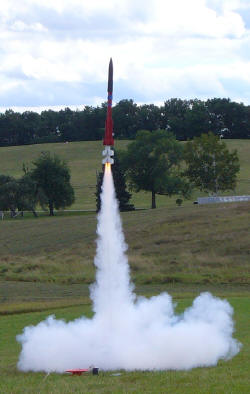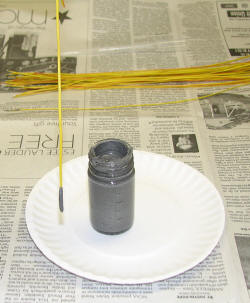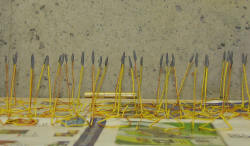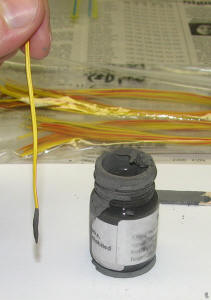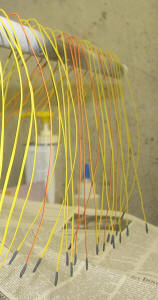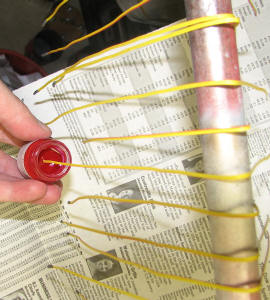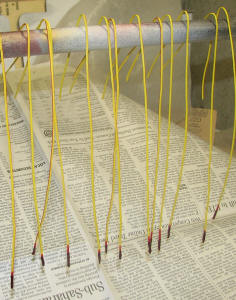|
Flight Tests: Clusters
and Deployments using Rocketflite MF Ematches
At the 4/19/08 CMASS launch in Amesbury, MA:
Flight 1: the TOGinator
Loaded with
26x D11-P engines. At 468 Ns total
impulse,
this was a
mid-I
power BP liftoff.
The MF ematches were set up in 8 strings of 3 MFs in series plus 1 string of
2 MFs in series.
Confirmed resistance / continuity before connecting the 9 series strings of
MFs in parallel.
Comparing ignition system current load, ignoring transient
effects for simplicity: For this flight using MFs in series strings of 2 or
3, the total launch system load was about 48A.
Using a typical igniter like the Rocketflite ML all in parallel, the igniter
system would attempt to draw about 300A. Also used MF’s to fire the two
ejection charges using a Perfectflite HA45K altimeter.
The liftoff was dramatic, with the jets of flame spread wide,
big cloud of smoke, and every engine firing! The rocket lifted off quickly
due to the 160 lb thrust spike at the beginning of the engine burn.
All 26 engines fired, as did both ejection
charges.
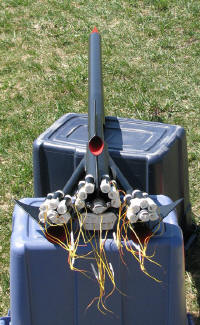 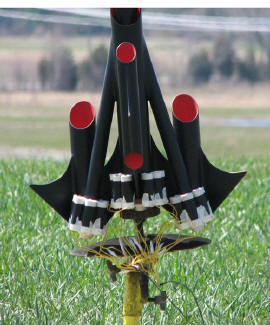
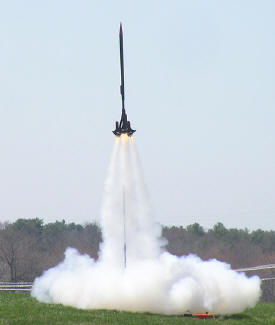
The TOGinator getting prepped and then all wired
up at the pad about to fire 26x D11-P engines with a parallel and series
setup of
Rocketflite MF ematches. Lifting off on a
fan of flame and smoke.
Thanks to Jim Flis for the flight photo and the many cool
FlisKits that inspired this rocket.
Flight 2: The
Ultimate FireBall
Loaded with
a 7x AP engine cluster made up of AeroTech 29mm engines:
4x F40W’s and 3x
G77R’s.
Total
impulse for the flight was 635 Ns,
full
I power using 29mm
engines.
The 4” diameter rocket was 7.5 ft
tall and 9.3 lbs at liftoff.


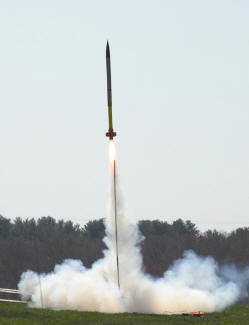
photo Guillaume Meriaux
The Ultimate FireBall
wired with a parallel and series setup
of Rocketflite MF prototype ematches
firing 7x 29mm AP engines.
All engines fired,
sending the rocket soaring on a cool looking rose colored flame
with a white core, due to the red G’s and white F’s. Both ejection charges
fired for good dual deployment recovery on a Top Flight Recovery 5 ft
Crossfire chute.
MF ematches fired the
engines set up in 2 series strings of 2 MFs and 1 series string of 3 MFs,
and also fired the two ejection charges.
The MF’s in series only required
about 20A, compared to a parallel igniter load of about 80A.
Rocketflite prototype
MF ematches made it possible to fire everything 100% successfully with one
type of ematch:
7 AP engines, 26 BP engines and 4 ejection charges.
Tests: Instant AP ignition
Using AT 29mm G64W
engines, experimented with adding Rocketflite ML pyrogen
inside the top of the propellant slot, about 2x what would go on an igniter,
and successfully achieved near instant
engine ignition. For these tests lightly sanded
inside the propellant slot first.
Evaluated the speed of ignition by attaching an LED light to the pad
ignition circuit in parallel with the MF ematch and video recording the
launches. By counting video frames, determined that the added ML pyrogen had the G64’s up to pressure within 0.1 second. Without
“extra help” a G64 typically comes up to pressure in 0.3 to 0.5 seconds.
The method I prefer to boost
AP ignition speed is Rocketflite ML pyrogen, as that poses the least risk of
over pressurizing the engine.
Now I was ready to fire
mixed engine types in clusters with confidence that all engines would be
firing before the rocket started to rise up the launch rod.
J and K Impulse
Clusters
At NERRF 4 used MF’s with
100%
success to fire 12 BP engines, 6 ejection charges and 11 AP 29mm engines
including:
> VooDoo Daddy twice: including Paul's first
cluster
> Apollo Saturn V twice: first for my L2, second a
K impulse cluster
> Ultimate FireBall on a 7x G cluster
The
Saturn V went up fast on a 5 engine K impulse cluster,
with a Cesaroni K-445 and 4x G64's. Used a Rocketflite ML igniter for
the center motor and MF igniters in the G64's. Worked like a charm, kicking
all five engines instantly for a hard long thrust to 3,372 ft. Total impulse
2095 Ns.
The Ultimate FireBall
went up on a J powered cluster of 7x RoadRunner
G80-10’s, ignited by MF's. Fast smoky liftoff to 2462 ft.
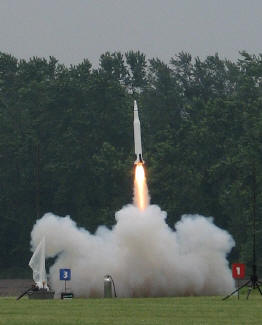
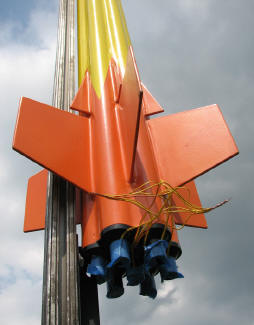
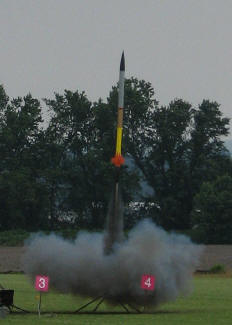
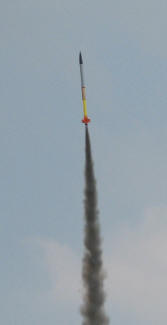
Apollo Saturn V cluster
Ultimate FireBall prepped with MF ematches..................and lifting off
fast .
.
At CMASS
on 10/4/08 the
FlisKits inspired TOGinator
flew again. The upper body had been rebuilt and also had gained four more engine tubes
and was now prepped to fly with a 30 engine J powered cluster of 3x G71R +
12x E9 + 15x D11-P engines.
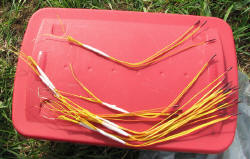
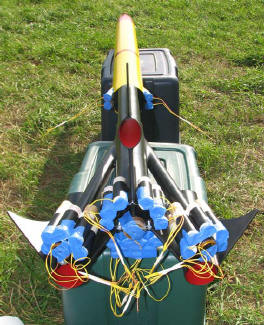
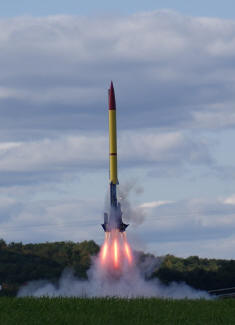
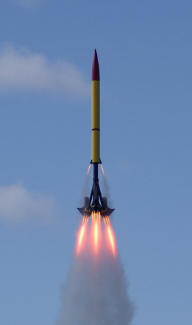
.
photo Doug Gardei
photo Doug Gardei
Series strings of 3 MF
ematches ready to be inserted into rocket engines. The TOGinator wired
up with 30 MF ematches set up in series and parallel. At
the pad another wire was run to the upper engines.
The flight lifted off
on a wide fan of yellow flames cut through with three longer spikes of red,
soaring to 1260 feet, mid-afternoon on a clear cool day. This was the flight
I had been working up to for nearly a year.
The propellant slots in
the Redlines were lightly sanded, and there was a small amount of
Rocketflite ML pyrogen at the top of the slots, causing them to come up to
pressure at the same time as the BP engines.
The MF's fired in every
engine and both ejection charges. Three of the D engines did not ignite
because (I discovered later) there was clay in the nozzles covering the BP,
so 27 engines fired. Prepped with 910 Ns, fired 856 Ns, still a
mid J
powered cluster of AP and BP engines.
MF ematches fired the
engines set up in 8 series strings of 3 MFs and 3 series string of 2 MFs
wired together in parallel,
and also fired the two ejection charges. The 30 MF’s in series/parallel only required
about 65A from the launch system, compared to a parallel igniter
setup which would attempt to draw
about 360A.
At a
later launch, the 10" Cluster Saucer got a good liftoff fired by MF's on the same 3x
D11-P engines that had not fired in the TOGinator flight, after the clay in
their nozzles had been carefully removed.
2008 Flight Results
As a practical and fun
way to field test Rocketflite’s 26awg prototype MF ematches,
I used them for
every ejection charge, BP engine, and 29mm AP engine flown in 2008. Results using Rocketflite 26awg MF ematches:
> Ejection charges: 15 attempts / 15 successful
> 148 engine ignition attempts, of these:
* 142 fired on the first attempt
* 3 had clay covering the BP in the nozzle and were fired later after this
was removed
* 1 was an old stubborn F21W, which confirms that a hard to light engine
likes a long firing igniter
* 2 were engines in good condition that did not fire due to apparent failure
of the MF ematch
Engine ignitions (BP and AP): 144 attempts with engines in good condition /
142 successes.
Bottom line, Rocketflite prototype MF ematches provided 99% reliability in
the field.
The MF ematches achieved this performance while requiring much less current
than typical igniters.
Lessons learned
firing MF ematches
A single MF can be
fired by one AA
alkaline 1.5 volt battery, allowing the most basic launch system to fire
anything up to a 29mm AP engine.
Small clusters of MF’s
may be fired by 6V to 9V ignition systems. Ground testing an ignition system
is a good idea prior to flying clusters.
Large clusters should
be fired by a strong 12V ignition system with a relay.
• Rocketflite ML
igniters or MF ematches can be used in parallel for up to approximately 8
engines
•
Combine series and
parallel MF’s for clusters to reduce ignition current load. Have fired 26-30
MF’s at once, 60+ should be possible.
•
Secure wiring – no
whip clips
Also consider:
•
Sand propellant slots
– remove oxidation
•
May accelerate
ignition with ML pyrogen at the top of an AP engine’s propellant slot
Disclaimer
Please note that I do
not speak for or represent Rocketflite. Rocketflite has sent me
supplies for tests.
What I have written describes my tests and projects as
an individual rocketeer.
Please see
www.rocketflite.com for more information.
|

